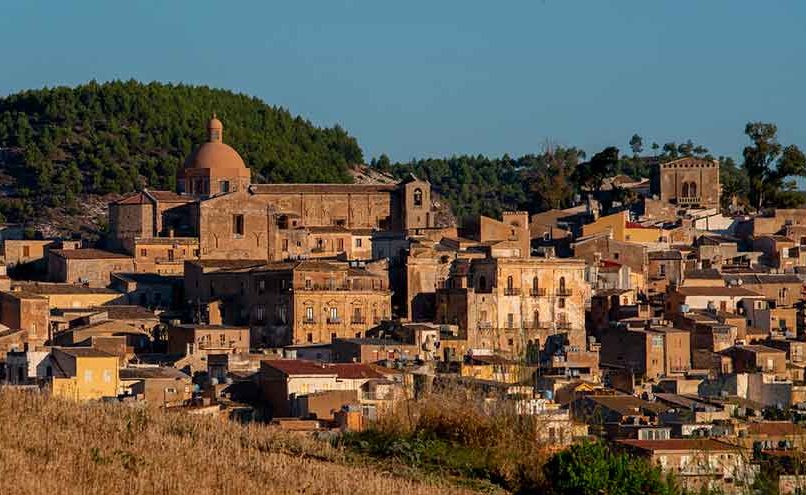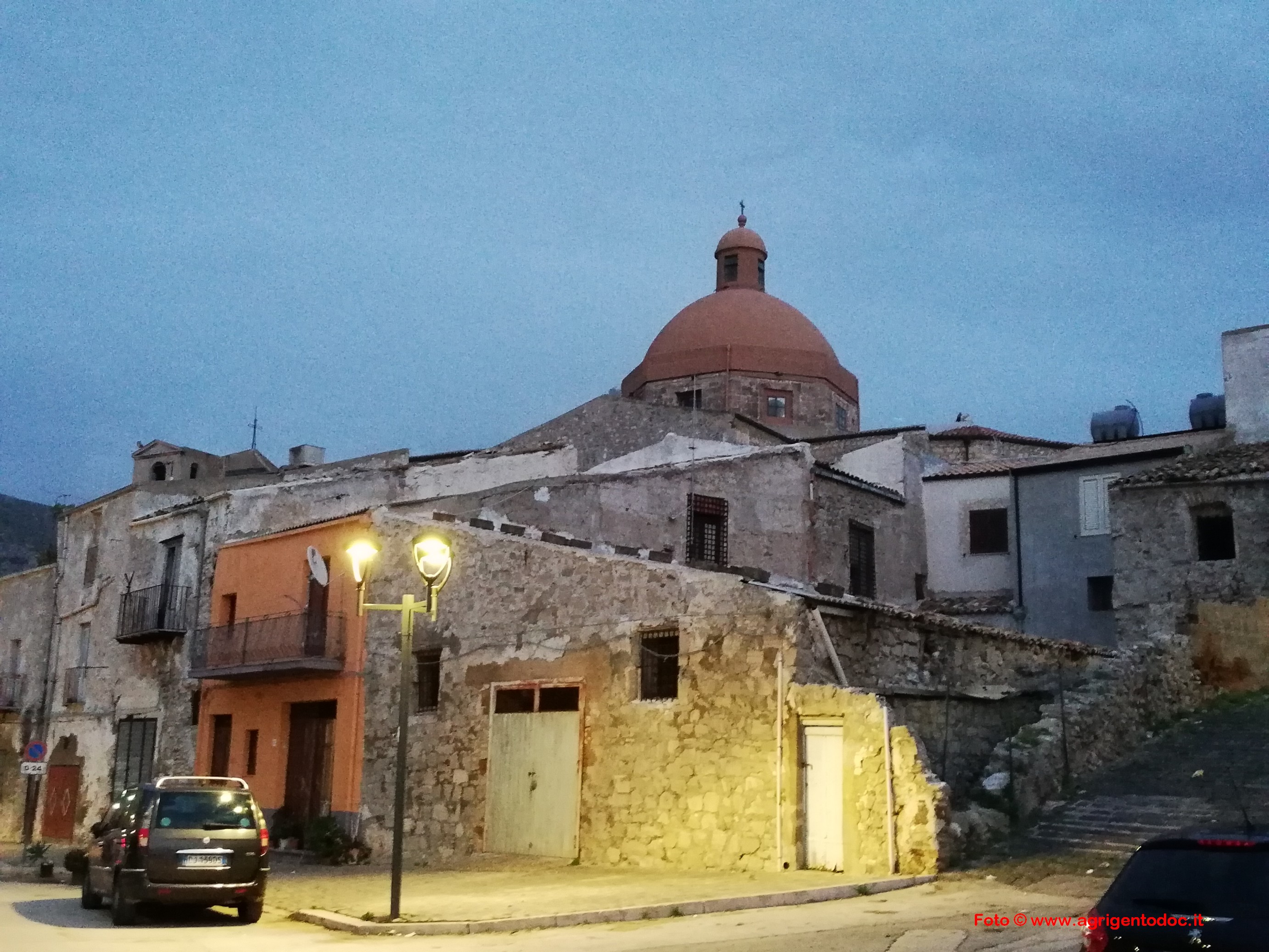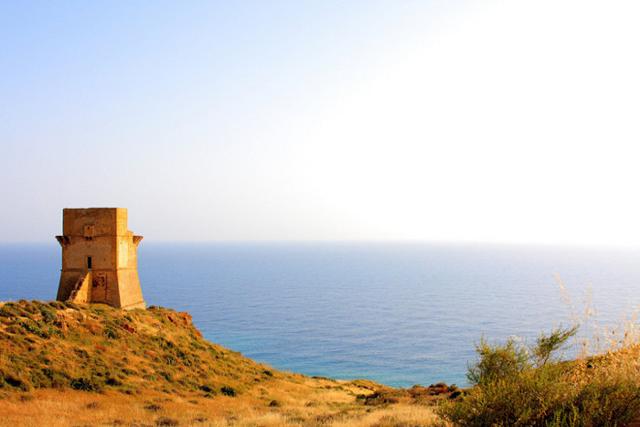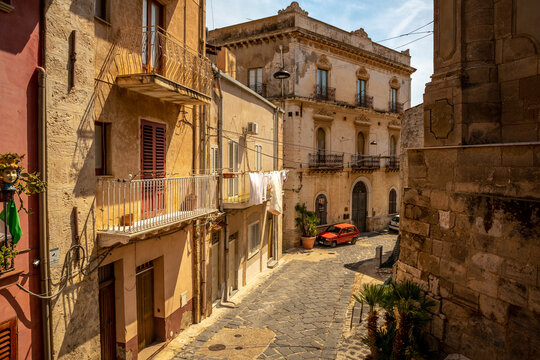



According to Filippo Cluverio, Siculiana was built on the site where the city of Cena once stood, of which Father Massa mentions in the work Of the cities of Sicily that no longer exist, a city where the Roman emperor Antonio Pio made a stop on his visit in Sicily. But elsewhere Cluverio himself states that Siculiana was built on the ruins of the ancient Camico, the residence of Cocalo, king of the Sicani, designed by Daedalus, where the architect found shelter during his escape from Crete.

A tradition reports that it was in Camico that the Cretan king Minos was killed by the three daughters of Cocalo; the latter attracted him under the pretext of taking a bath in the thermal waters of the area, but, after having flattered him, they immersed him in a tub full of boiling water (according to others, liquid pitch), killing him. The exact location of the Camico site extends from the territory of Sant'Angelo Muxaro to Agrigento, or Naro, above Mount Castellaccio, as well as to Caltabellotta, in the Guelà cliff, which is an area full of caves, called Gogàla. The origin of the town's name is traced back to its natural port on the navigable river Canne, which made stopovers safe.

This earned the area the Latin name of Siculi Janua, meaning "Gate of Sicily". Siculiana is also known for the presence of the "Caricatore", that is the port specialized in the grain trade, also known as "Herbesso" in the Roman-Punic age, in the Arab period as "Tirsat Abbad", around the sixteenth century as "Cola- Cortina "and later simply as" Il Caricatore di Siculiana ". During their domination in Sicily, the Arabs built the castle of Kalat Sugul in Siculiana. Later, the castle is mentioned among the eleven castles that resisted the assaults of King Roger the Norman and was razed to the ground after the surrender of Girgenti.
In 1161 the territory of Siculiana was granted to the Norman nobleman Matteo Bonello, Grand Chancellor of the Kingdom, as can be seen from the document "Diploma di Guglielmo I".
In 1296 Federico III, king of Sicily, gave the investiture of the Siculiana barony to Federico Chiaramonte. The latter built the castle of Chiaramonte on the ruins of the Arab castle and re-founded a pre-existing Siculiana farmhouse near it. On this basis the surrounding town took shape. Castello Chiaramontano di Siculiana The fame of the castle grew on the occasion of the second marriage of the only daughter of Federico Chiaramonte, Costanza, who was the first to marry Antonio del Carretto, marquis of the states of Savona and Finale.
The latter had obtained the baronies of Calatabiano and Siculiana and the county of Racalmuto as a dowry from Federico Chiaramonte. From the first marriage a male heir was born, which bears the name of the father, who died prematurely; so the noble Costanza went to second marriage with the Genoese noble Brancaleone Doria, who was appointed governor of Sardinia in 1335. On the death of Federico Chiaramonte, which took place in 1311 in Girgenti, where his mother had founded the Convent of San Francesco and the Monastery of Santo Spirito, the barony was inherited by the only daughter, Costanza.

When the latter died, the barony passed to the son from the first marriage, Antonio del Carretto Chiaramonte, a fact that is also documented by the census of Martin I, carried out in 1413. The barony and the castle belonged to the Chiaramonte family until 1427, when it appeared in the Sicilian territory the noble of Catalonia Gilbert Isfar y Corillas, who came in the wake of King Alfonso the Magnanimous, who had conferred on him the title of secret master of the Kingdom; he bought the whole Sicilian territory, including the castle in 1430 and, more importantly, the right to export from the maritime emporium, thanks to which, during the very serious famine in Sicily, he was able to export wheat with hefty earnings.
In 1440 Gilbert Isfar became Vicar General of the Kingdom, after thirty years the title passed to his son Giovanni Gaspare who, under the consent of King Alfonso, also incorporated the territory of Monforte into the Sicilian territory. When he died, his son Vincenzo inherited the fiefs and sold Siculiana to Guglielmo Valguarnera, but the family reigned in the barony only for a short period. In fact, in 1526 this was given as a dowry to Giovannella, daughter of Baron Blasco Isfar, wife of Vincenzo del Bosco, Duke of Misilmeri and Prince of Cattolica.
Baron Blasco Isfar is remembered as one of the greatest chess players in the world; he was also a great lover of botany, in fact it is said he delighted in carrying out the planting in the gardens of the Chiaramontano castle, flora now destroyed by the renovations of the new owners. On 20 July 1610 with a notarial deed between Blasco Isfar and the Bishop of Agrigento Vincenzo Bonincontro, the baron ceded the steri (from the Latin hosterium = fortified palace) of the Chiaramonte to the Bishop, with the only condition that three young people, two of Siculiana and one of Cattolica. Thus began the very slow development of the town, which in those years contained only 38 houses.
In 1612 Philip III granted to Francesco Isfar, son of Blasco, the "licentia populandi" for Cattolica; he also granted him the titles of baron and then duke in 1615 of the new country. After the death of Francesco, which took place a year later, her sister Giovanna inherited the title, who in 1620 was nominated, again by Philip III, princess of Cattolica; and in 1631 she founded both in Siculiana and Cattolica the "Collegi di Maria" with the aim of educating the poor girls of these countries.

These arose throughout Sicily and in Siculiana one can venture the hypothesis that the management of these institutes could have been the work of the Carmelite nuns, according to the rule of St. Teresa of Avila, founder of the Discalced Carmelite nuns and friars. it never went into operation, since the funds were never sufficient, therefore the premises of the college were never activated and very soon became ruins. In 1655 Francesco del Bosco, from whom Giuseppe was born, was appointed prince of Cattolica and baron of Siculiana.
The del Bosco family managed to keep the barony until 1668, when their last heir died, Giuseppe del Bosco Isfar, who, despite his two marriages, had no children, therefore the noble title was inherited by his nephew, son of his sister. , carrying on the surname Bonanno, who became the lords of the two villages.
In 1720 the barony passed to Francesco Bonanno, son of Rosalia del Bosco and Filippo Bonanno, prince of Roccafiorita, duke of Montalbano and Misilmeri, gentleman of the chamber of King Vittorio Amedeo of Savoy and King Charles III, one of the twelve peers of the Kingdom. His family had such great fame that it was reported in the writings of many historians, including Mugnos, Inveges and Villabianca.

In 1736 he had the Villa Cattolica built in Bagheria, particular for its openings, 365, as many days of the year.
On the death of Francesco, his son Giuseppe Bonanno Filangeri inherited the enormous patrimony and noble titles such as that of Grande di Spagna and baron and Portulano Master of the Siculiana loader. He appointed his brother Don Emanuele Bonanno Filangeri as his Procurator General, entrusting him with all his baronies and his states because due to his duties he had been forced to go to Naples to carry out his innumerable duties. However, his distance from the town of Siculiana determined the decline of the family, since the standard of living they maintained at the court of Naples caused economic failure.
On the death of Giuseppe Bonanno, which occurred in 1779, he was succeeded by his son Francesco Antonio Bonanno Filangeri, husband of Caterina Branciforti of the Princes of Butera. The family hit economic bottom in the mid-1800s, when Prince Francesco Bonanno, who had three daughters and two sons, one of whom died celibate, married the three daughters to men who did not have noble titles. They came to touch poverty in the true sense of the term when Francesco Bonanno squandered all his possessions and properties to equate the dowry of one of his daughters with that of his future son-in-law.

From this story derive the Sicilian proverbs regarding the birth of female daughters, such as, for example, when a couple announces the expectation of a child, the wish they are given is: "Auguri e figli masculi" (Greetings and male children) , or, even better: "The masculine sons sunnu meli, the fimini sons sunnu feli" (The sons are like honey, the daughters are like gall); the first proverb is still in use. On 10 July 1812 the Sicilian Parliament abolished the baronage and therefore the family lost all noble privileges.
The Bonanno family again obtained the barony with the ministerial decree of 1898: the last descendant of the family was a Bonanno Perez. The Pisan baron Nicolò Agnello, in an auction given for the expropriation of the Church's land by the Kingdom of Italy, won the ownership of the castle and the barony, which he managed to keep until 1915, when he was then joined by the other noble families of the town, such as the Scaramazza, the Scalia and the Basile. Baron Francesco Agnello, Nicolò's brother and father-in-law, as the husband of his niece Caterina, was elected deputy in the Parliament of Sicily in 1848, made independent by the revolution.

Siculiana had, therefore, a fundamental role in the revolutionary movements of '48, in order to free Sicily from Neapolitan domination. Under the guidance of the archpriest of the time, Giuseppe Syracuse, a fervent independentist, the current Matrice, the church of the Santissimo Crocifisso, became the center of political aggregation in the fight against the Bourbons, in which the Agnello family also participated, together with other Sicilian families of different social ranks, including Cavaliere Giuseppe Campo.
According to the testimonies of the time, at the time of Baron Francesco Agnello, the castle hosted some illustrious characters, such as the writer Tomasi di Lampedusa who, in those rooms, wrote some pages of the novel "Il Gattopardo". Among the guests of Baron Francesco Agnello we must remember the German composer Karlheinz Stockhausen who in Siculiana in January 1962 began to work on his composition entitled "Momente". In more recent times, in the 60s, Alberto Moravia visited the village, who, in the company of Monica Vitti, Enzo Siciliano and Dacia Maraini, stayed in the Sicilian territory, in order to finish his novel "Attention".

A journalist from Agrigento interviewed him while he was in the rooms of the Castle and reported Moravia's words on the town of Siculiana, defining it as a "perfect country, born from the earth", a poor country, but without industrialization, adding: "... .there is an almost suffocating heat .. it is as if the whole town was breathing and from my room I can catch the sentences uttered by every passerby being able to hear him while he acts and moves among friendly things that do not deprive his doing of genuineness ".
Siculiana Village
Address: via Picarella, Quartiere Casale, 92010
Phone: +39 329-9681701
Site:
http://www.comune.siculiana.ag.it/hh/index.phpLocation inserted by
Emanuale Rossi